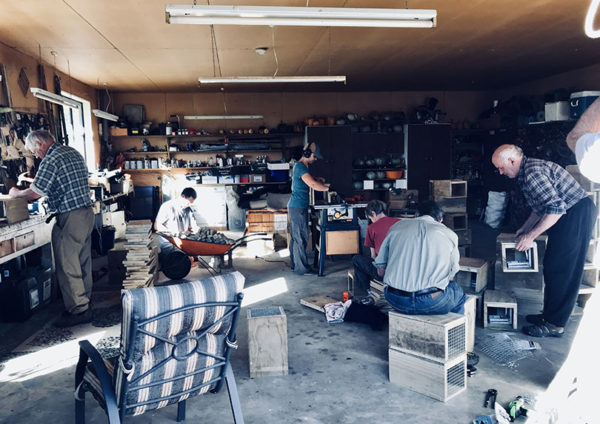Ashley River midwinter 2018
Birds. As usual, all is rather quiet at the moment – it being winter when all our usual species are away in their winter quarters. I walk from Groyne 1 to G2 every month, and on the last trip, the only indigenous species observed were a handful of black-fronted terns (plus a couple of harriers). The other few species present were all relatively recent arrivals from off-shore – spur-winged plovers (one flock numbered around 90 birds), welcome swallows and white-faced herons (plus small flocks of greenfinches).
Predators. Trapping goes on as usual, with 13 trappers checking 173 traps. We often catch more predators in the autumn, when hunger sets in and young animals are driven out from parent territories. There seem to be more feral cats around this year – 11 have been caught since February. In the near future, we are going to offer trappers the use of trail cameras so that they can learn about what happens around their traps when they are not there.
Weeds. As many of you will know, some work we did on weed invasions over recent years showed a remarkably close relationship with bird numbers. The greater the amount of infested riverbed, the lower the number of birds. Fortunately, major floods in the 2017 winter and early spring vastly increased the areas of clear shingle (from 30ha to around 250ha), but we still went ahead with machine clearance of remnant weeds in the sites most favoured for bird nesting. As one cannot guarantee decent floods on a regular basis, we intend to keep these areas free of weeds permanently, and to this end, we carried out some spraying of regrowth in the autumn. Right now, we are also experimenting with riverbed ripping to try to determine a cost-effective means of maintaining weed control without involving chemicals. Thanks to Grant Davey for all his mapping of weed areas, bird breeding sites and trap locations.
Humans. Even though fewer people venture down onto the riverbed over winter (for obvious reasons), there can be more 4WD traffic. This is because the agreement we (and ECan) have with the Combined 4WD club is that we will block off access during the bird breeding season (Sept – Feb), but will remove most blockages and ‘keep out’ signs outside that period. But with more and more people possessing off-road machines, there is increasing pressure for access onto challenging terrain. The network of tracks in the northern berm area (the well-vegetated strip between the stopbank and the fairway) from the SH1 bridge to the railway bridge, deliberately offers such challenges – to encourage drivers to operate there rather than in the open riverbed.
Trap making and workshops
Trap making. This has become quite a small ‘business’ for the Group, with almost 200 made since Christmas. Seventy were ordered by Project Makarora (western Otago), with another 90 made for the new Ashley-Saltwater Creek estuary group. It is planned to help the latter to install their traps around the estuary margins over the next couple of months. The usual thanks to Geoff Swailes for organising the trap-making, plus the use of his garage to do the work.
Workshops. With Predator Free NZ in full swing, we have recently assisted DOC in a number of public trapping workshops. These usually attract 50+ attendees and are a great way to promote not only predator control but also the plight of our braided river birds.

Education, awareness and promotions
There are very few of the public who do not support our efforts to improve the numbers of the special bird species which breed on braided rivers. But needless to say, that support only surfaces if they are aware of the issues. Hence, improving public awareness is arguably our biggest single challenge.
Schools. We speak to as many school students as possible because they are the carers of the future – plus they are also the most receptive to conservation stories. Rangiora High School has recently begun a long-term study of within-river life (aquatic insects, small fish etc), led by their Blue Planet group. They will monitor changes over the year, plus determine the likes of favoured areas and recovery rates after floods. This will be really useful information, as we know heaps about bird numbers and breeding, but very little about their primary food sources.
Video/ documentary. Over the summer months, some of us spent many hours with Oxford filmmaker, Tony Benny, taking footage for a documentary of a typical season’s activities by the Group. We filmed all the major bird species, a survey being undertaken, trappers doing their rounds, plus meetings and talks to schools and outside groups – with many interviews of participating players. Now the footage is with the editors, and we hope to see the first drafts in the near future.
Support by Karikaas cheesemakers. Our improved public profile over recent years has meant that we are now supported by many agencies and a few private businesses. A recent and welcome addition has been Karikaas cheeses in Loburn. They have partnered with ourselves and BRaid Inc by featuring riverbed birds on some of their vintage cheeses. Their ‘wrybill’ braided river bird Gouda recently won a gold medal and is now sold in both islands. We get a donation for every ‘bird’ cheese sold. Needless to say, we are most grateful for such support – and urge you all to try a Karikaas vintage cheese (available in local supermarkets).
Nick Ledgard
Chair, Ashley-Rakahuri Rivercare Group and BRaid Inc




